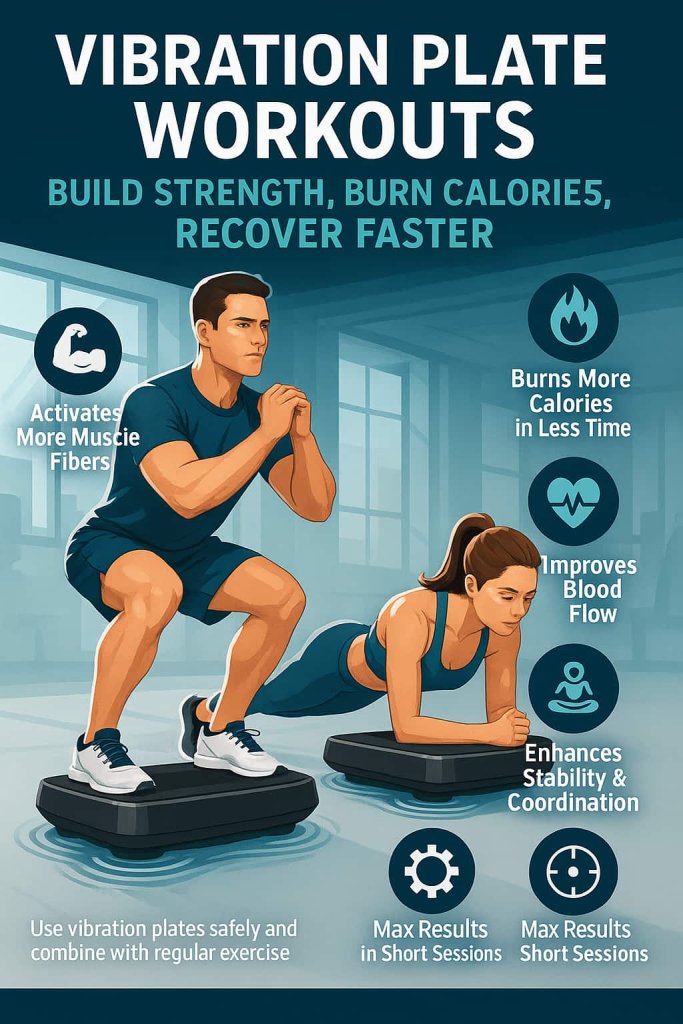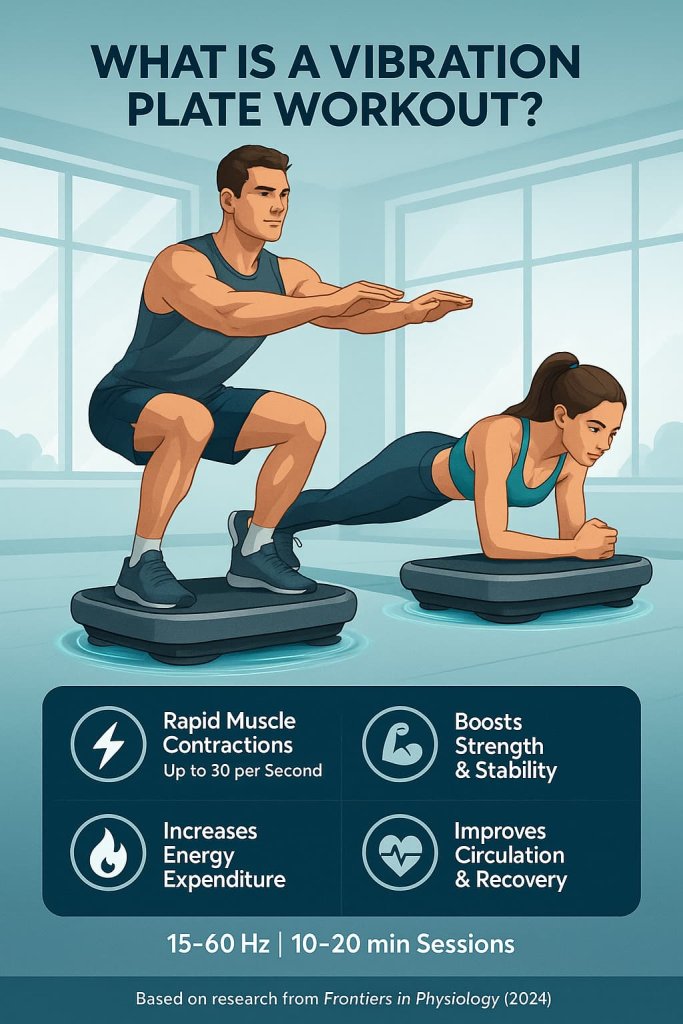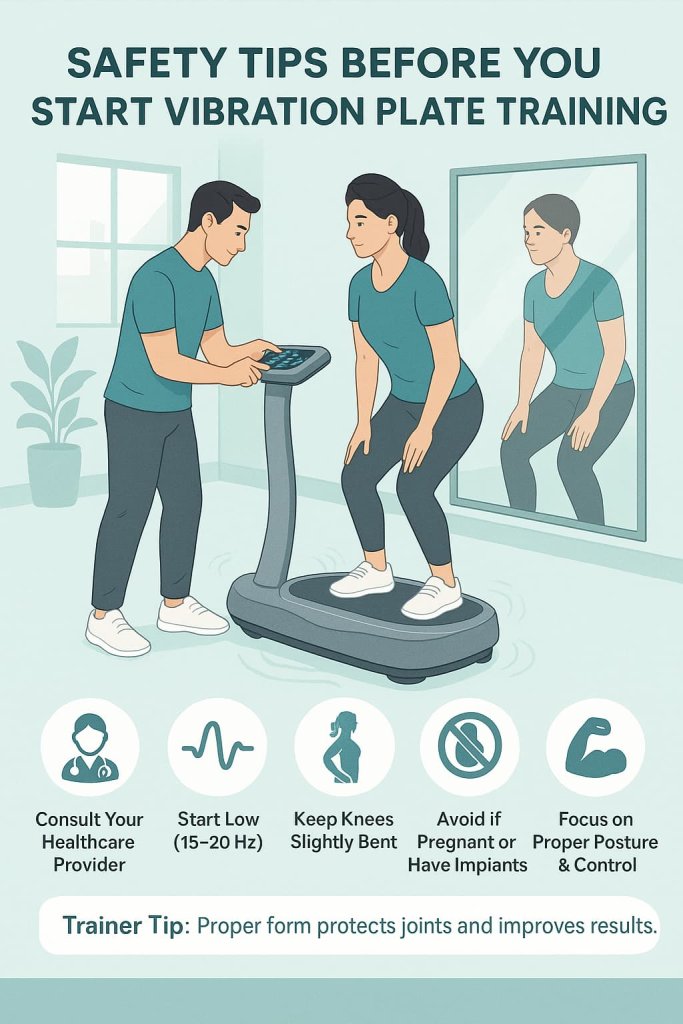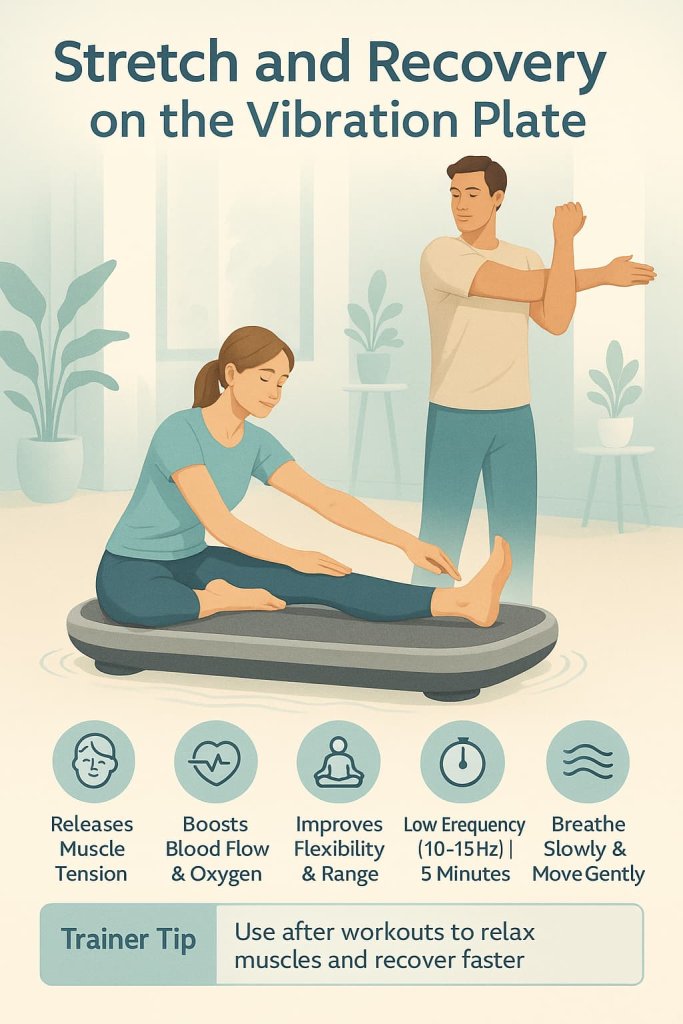Vibration plate workouts can help you build strength, burn calories, and speed up recovery — but they work best when combined with traditional exercise.
These workouts use rapid whole-body vibrations to stimulate muscle contractions, improve circulation, and enhance muscle activation in less time.

Understanding how to use vibration plates properly is key to maximizing results and avoiding injury. Below, we’ll explain how they work, their benefits, and the 10 best vibration plate exercises to get started safely and effectively.
What Is a Vibration Plate Workout?
A vibration plate, also known as a whole-body vibration (WBV) machine, is a platform that moves rapidly in small oscillations. When you stand, sit, or perform exercises on it, the vibrations force your muscles to contract and relax dozens of times per second — enhancing strength, balance, and blood flow.

How It Works
According to a 2024 review in Frontiers in Physiology, WBV stimulates neuromuscular activation, increasing energy expenditure and improving muscle power when paired with resistance exercises.
Typical vibration frequency: 15–60 Hz
Session duration: 10–20 minutes
Safety Tips Before You Start

Before using a vibration plate:
- Consult your doctor if you have joint, heart, or balance issues.
- Start with low frequency (15–20 Hz) and short sessions.
- Keep knees slightly bent to absorb vibration safely.
- Avoid using the machine if you are pregnant or have metal implants.
Trainer Tip: Always focus on form — improper posture can reduce benefits and increase strain.
10 Best Vibration Plate Workouts
These 10 vibration plate exercises target every major muscle group to build strength, balance, and endurance in less time.
Practice them 2–3 times per week to maximize results while improving flexibility and recovery.
1. Squats
Why it works:
Vibration-enhanced squats recruit more muscle fibers than traditional versions. The rapid oscillations stimulate the glutes, quads, and hamstrings, helping you build lower-body strength, stability, and tone faster. It also improves balance and posture by engaging your core to stabilize your body against vibration.
Muscles worked:
Glutes, quadriceps, hamstrings, and core.
How to do it:
- Stand with feet shoulder-width apart on the vibration plate.
- Keep your chest upright and core braced.
- Lower into a controlled squat, ensuring knees track over toes.
- Hold for 30–45 seconds, then rise slowly.
- Repeat for 3–4 sets.
Trainer Tip:
Keep your heels flat and avoid locking your knees at the top. Focus on maintaining a steady, upright posture for maximum benefit.
2. Push-Ups
Why it works:
Performing push-ups on a vibrating surface increases muscle activation in your chest, shoulders, and triceps. The instability challenges your stabilizers, improving upper-body strength and endurance.
Muscles worked:
Pectorals, triceps, deltoids, and core stabilizers.
How to do it:
- Place both hands shoulder-width apart on the vibration plate.
- Extend your legs straight behind you into a plank position.
- Lower your chest slowly toward the plate, keeping elbows at 45°.
- Push back up to the start position.
- Perform 8–12 controlled reps.
Trainer Tip:
Keep your body in a straight line from head to heels. Beginners can modify by keeping knees on the ground.
3. Plank Hold
Why it works:
The vibration plate increases engagement of deep abdominal muscles by forcing your core to stabilize your body against micro-movements. It strengthens your abs, back, and shoulders simultaneously.
Muscles worked:
Rectus abdominis, transverse abdominis, shoulders, and lower back.
How to do it:
- Place your forearms on the plate, elbows under shoulders.
- Extend your legs back, forming a straight line.
- Keep your core tight and avoid sagging hips.
- Hold for 30–60 seconds.
Trainer Tip:
Breathe steadily and keep your glutes tight for full-body tension.
4. Calf Raises
Why it works:
Vibration stimulates the smaller stabilizing muscles in your calves and ankles, improving circulation, balance, and endurance. Excellent for runners and anyone with tight lower legs.
Muscles worked:
Gastrocnemius, soleus, tibialis anterior.
How to do it:
- Stand with the balls of your feet on the vibration plate.
- Keep your knees slightly bent and hold onto a stable surface if needed.
- Rise up onto your toes, pause for 2 seconds, then lower slowly.
- Repeat for 15–20 reps.
Trainer Tip:
Control each movement — avoid bouncing. To increase challenge, hold a dumbbell or use one leg at a time.
5. Lunge Hold
Why it works:
This isometric move strengthens the quads, glutes, and hamstrings while training balance and coordination. The vibration intensifies muscle engagement and stability.
Muscles worked:
Quadriceps, gluteus maximus, hamstrings, calves, and core.
How to do it:
- Place your front foot on the plate and back foot a few feet behind.
- Lower into a lunge until both knees form 90° angles.
- Hold for 30 seconds, switch legs, and repeat.
Trainer Tip:
Keep your front knee aligned over your ankle. Avoid leaning forward — maintain an upright torso.
6. Glute Bridge
Why it works:
The vibration increases glute and hamstring activation while enhancing hip mobility. This move strengthens the posterior chain and supports lower back health.
Muscles worked:
Glutes, hamstrings, lower back, and core.
How to do it:
- Lie on your back with feet on the vibration plate and knees bent.
- Engage your core and squeeze your glutes to lift your hips.
- Hold at the top for 3–5 seconds, then lower slowly.
- Repeat for 12–15 reps.
Trainer Tip:
Avoid arching your lower back — focus on driving through your heels and tightening your glutes at the top.
7. Side Plank
Why it works:
Vibration increases muscle engagement in your obliques and stabilizers, improving balance and side-core strength. It also strengthens the shoulder and hip on the supporting side.
Muscles worked:
Obliques, transverse abdominis, shoulders, and hips.
How to do it:
- Place your forearm on the vibration plate.
- Stack your feet and lift your hips until your body forms a straight line.
- Hold for 20–30 seconds per side.
Trainer Tip:
Keep your neck in line with your spine. If balance is difficult, bend your bottom knee for support.
8. Bicep Curls
Why it works:
Standing on a vibrating surface recruits more stabilizer muscles while performing curls, increasing overall muscle activation in the arms and core.
Muscles worked:
Biceps brachii, brachialis, forearms, and core.
How to do it:
- Stand on the plate holding light dumbbells in each hand.
- Keep your elbows close to your torso.
- Curl the weights toward your shoulders, then lower slowly.
- Perform 10–15 reps.
Trainer Tip:
Avoid swinging your arms — use a slow, controlled motion for maximum tension.
9. Step-Ups
Why it works:
Combining step-ups with vibration improves leg strength, cardiovascular fitness, and coordination. The unstable surface forces your stabilizers to work harder.
Muscles worked:
Quadriceps, glutes, hamstrings, and calves.
How to do it:
- Step one foot onto the plate, then bring the other foot up.
- Step back down in control, alternating legs.
- Continue for 60 seconds.
Trainer Tip:
Keep your torso tall and drive through your heel to activate your glutes. Add dumbbells for extra resistance once you’re stable.
10. Stretch and Recovery
Why it works:
Low-frequency vibration helps relax muscles, boost circulation, and promote recovery by increasing blood flow and oxygen delivery post-exercise.

Muscles worked:
Full-body (focus on relaxed mobility and flexibility).
How to do it:
- Sit or stand on the plate at low frequency (10–15 Hz).
- Perform light stretches for the hamstrings, calves, shoulders, and back.
- Continue for 5 minutes.
Trainer Tip:
Use this as a cool-down after your workout. Focus on slow breathing and gentle stretching to enhance recovery.
How to Use a Vibration Plate Correctly
To get the best results safely, focus on proper setup, form, and frequency.
- Start Slow: Begin at 15–20 Hz for 10–15 minutes, and gradually increase to 30–40 Hz.
- Keep Good Posture: Stand tall with knees slightly bent and core engaged to absorb vibration.
- Move with Control: Avoid bouncing — hold positions and let the vibration activate your muscles.
- Warm Up & Cool Down: Stretch or move lightly for 3–5 minutes before and after each session.
- Pair with Regular Training: Use it to complement, not replace, your strength or cardio workouts.
- Stay Safe: Place it on a stable surface, wear supportive shoes, and stop if you feel pain or dizziness.
Trainer Tip: Proper form and short, consistent sessions deliver better results than high intensity or long duration.
How Often Should You Use a Vibration Plate?
According to the American Council on Exercise (ACE, 2024), start with 2–3 sessions per week of 10–15 minutes each. Advanced users can train up to 4–5 times weekly when combining with regular strength or cardio routines.
Potential Drawbacks and Who Should Avoid It
Avoid vibration training if you have:
- Pregnancy
- Pacemaker or implants
- Recent fractures or surgeries
- Severe osteoporosis or migraines
Always check your manufacturer’s safety guidelines before starting.
Sample 20-Minute Vibration Plate Routine
| Time | Exercise | Frequency | Duration |
|---|---|---|---|
| 0–3 min | Warm-up stretches | 15 Hz | 3 min |
| 3–7 min | Squats + Calf Raises | 25 Hz | 4 min |
| 7–10 min | Push-Ups + Plank | 25–30 Hz | 3 min |
| 10–14 min | Lunges + Glute Bridges | 30 Hz | 4 min |
| 14–18 min | Bicep Curls + Step-Ups | 30–35 Hz | 4 min |
| 18–20 min | Stretch & Cool Down | 15 Hz | 2 min |
Key Benefits of Vibration Plate Workouts
1. Build Strength Faster
Research shows that whole-body vibration increases EMG muscle activity during squats and push-up positions, indicating higher muscle recruitment—especially in the legs and core.
2. Burn More Calories
A study in PLoS One (2023) reported that 20 minutes of vibration exercise increased calorie burn by approximately 20% versus the same workout without vibration.
3. Improve Flexibility and Mobility
Whole-body vibration supports joint range of motion and helps loosen tight muscles — ideal for recovery days.
4. Boost Balance and Coordination
For seniors and beginners, whole-body vibration can improve balance/proprioception and may help lower fall risk, based on a blinded randomized trial in older adults and recent reviews.
5. Support Post-Workout Recovery
Enhanced blood flow and lymphatic drainage promote faster muscle recovery and reduce soreness after training.
FAQs About Vibration Plate Workouts
1. Do vibration plates really help with weight loss?
They can support fat loss when paired with proper diet and exercise, but they’re not a standalone solution.
2. How long should I stand on a vibration plate?
Start with 10–15 minutes and gradually increase to 20 minutes per session.
3. Can seniors use vibration plates?
Yes—at low frequencies (~15–35 Hz), vibration-plate training can improve balance in older adults; evidence for bone density is mixed (small, site-specific gains in some studies, none in others).
4. Are vibration plates safe for daily use?
Yes, if used properly — but limit to 4–5 times weekly for optimal recovery.
5. Should I wear shoes on a vibration plate?
Yes. Supportive shoes help absorb vibration and protect your joints.
6. Can it replace strength training?
No. It’s most effective as a complement to traditional resistance or mobility workouts.
7. How soon will I see results?
With consistency, users often notice strength and flexibility improvements within 3–4 weeks.
Conclusion
Vibration plate workouts are an efficient, science-backed way to enhance strength, flexibility, and recovery — especially when combined with traditional training.
Whether you’re looking to tone muscles, improve balance, or speed up post-workout recovery, the key is consistency and correct form.
Ready to start? Try the 10-exercise plan above 2–3 times a week and feel the difference in your energy, strength, and mobility.
References
- Frontiers in Physiology (2024): Broad review showing WBV can improve strength, flexibility, balance, and coordination across populations.
Effects of whole-body vibration training on physical function. - Frontiers in Cell & Developmental Biology (2025): New evidence on WBV improving muscle mass/strength in older adults (sarcopenia context).
Whole-body vibration training improves muscle mass and strength in older adults. Frontiers - Systematic Review (2023, open-access PMC): In older adults, WBV increases lower-limb strength; mixed effects elsewhere — supports exercise selection.
Impacts of Whole-Body Vibration on Muscle Strength, Power and Endurance in Older Adults. - Experimental Study (2023, open-access PMC): WBV can raise energy expenditure and EPOC at low intensities — supports warm-up/cool-down guidance.
Effects of 4 weeks of whole-body vibration training on energy expenditure and EPOC.
